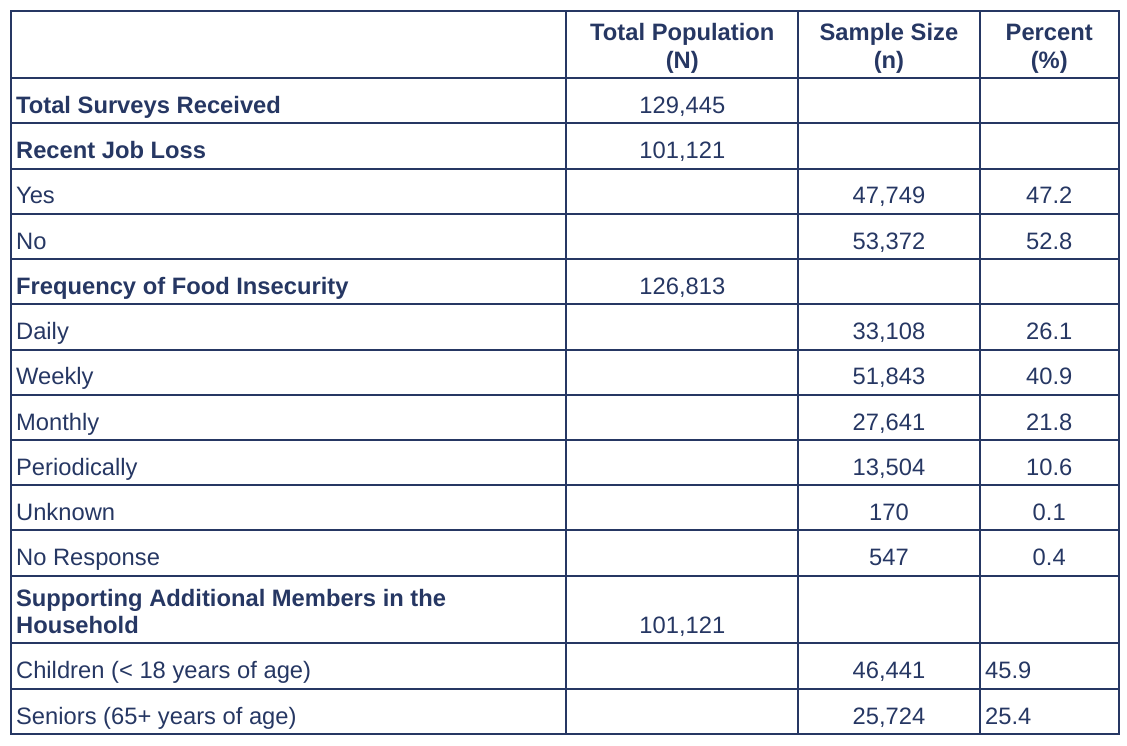
It’s Not Just Hunger: Economic Hardship & Food Insecurity

September 1, 2022
Since the start of COVID-19, the U.S. economy has fluctuated with food and energy costs continuously on the rise. As prices increase, families across the nation are struggling to stretch their finances to cover the costs of basic necessities, exacerbating the effects of food insecurity. As one Full Cart Recipient stated, “This year has been very hard. I am on a fixed income so the inflation has made it difficult to get by.” According to the U.S. Department of Agriculture, food insufficiency among Americans in July 2022 was 11.5%, a 3.5% rise over what was previously measured in August 2021.1 Food cost inflation has led to more households seeking food assistance as people attempt to provide enough food for their families.2 Households supporting children and/or seniors often experience higher and more severe (i.e., low or very low) food sufficiency, leading to higher demand for social services, such as food banks and government benefits.1,3,4 As one individual stated, “With the Cost of food going up at this point, food stamps are not even enough! Me and my family have been running out of our food stamp benefits by the middle of the month.” Within the U.S. Hunger (USH) surveys collected as of July 2022, a majority (40.9%) of those who requested food assistance self-reported weekly food insecurity (see Table 1). Additionally, the average household size reported was 3.67 people with 45.9% of respondents reporting that they support at least one child under the age of 18 and another 25.4% reporting that they support someone 65 years of age or older. Once household size reached 10 or more individuals, the severity of food insecurity worsened with families reporting daily, rather than weekly or monthly, food insecurity. Such results are indicative of the pressure individuals are facing as inflation rises and it becomes more difficult to obtain food.
In an effort to make ends meet, many of those requesting food assistance reported “cutting back” on essential items and described the tough decisions they are facing on a daily basis. Upon receiving a Full Cart box, one individual explained, “Thank you for lightening the financial burden of choosing if medication or groceries is most important this month. Buying fresh produce or even your standard staples has become increasingly difficult in the last few years. Fixed incomes are not flexible. When prices rise, fixed incomes do not.” While another recipient detailed, “Quality of life is declining due to high inflation. [I’m] feeling the economic effects. [The] food budget is first to be cut as a family in order to keep everything else in the household going.” While working individuals are struggling financially during the current economic climate, families that have experienced recent job loss are attempting to make ends meet with even fewer resources. At the time of submitting a request for food assistance, nearly half (47.2%) of the USH population reported a loss of income within the past two months. One Full Cart recipient reported, “[I] lost my job at the start of covid due to lack of resources for child care. I have been unemployed since and struggling to keep food and toiletries, not to mention bills, paid. I have not been able to bounce back.” This account is illustrative of the position in which many families currently find themselves. Individuals who have experienced recent unemployment are being forced to adjust to a lack of income as well as a lack of agency. They have to make difficult decisions to keep their families safe and fed, forfeiting the freedom to decide where to allocate their already limited financial resources.
These economic constraints are not confined to the USH population, nor are they temporary. Data and trends provided by the Bureau of Labor Statistics through the Consumer Price Index (CPI) reveal that Americans are currently experiencing historic price increases for food, energy, and shelter. The CPI is a measure of the fluctuation in prices for services and goods (e.g., food at home, gasoline, shelter, etc.) that are paid by urban consumers.5 According to the Bureau of Labor Statistics, from July 2021 to July 2022, the index for food increased by 10.9%. Within the same 12-month period, the energy index increased by 32.9% as the gasoline index rose by 44.0% and the electricity index went up by 15.2%.5 As prices for necessities have increased, many Americans are having difficulty stretching their budgets. One USH Full Cart recipient explained, “A lot of the time we can’t even go grocery shopping because that money needs to be saved for gas for my husband to be able to get back-and-forth to work.” Under the current economic conditions, individuals are being forced to make trade-offs. How do we ensure that our neighbors do not have to choose between food or gas from week to week? How can we make food more affordable and accessible to those who are socioeconomically disadvantaged? These are concerns that are being addressed at the White House Conference on Hunger, Nutrition, and Health scheduled later this month. At USH, we are committed to listening, documenting, and preserving the real-life stories of those affected by food and nutritional insecurity. Such voices should inform this historic convening and direct meaningful solutions to an issue that should not exist in America.
• • •
Subscribe to our Data & Research Newsletter Here.
U.S. Hunger (USH) is a non-partisan, not-for-profit established in 2010, which has mobilized more than 850,000 volunteers to distribute over 147 million nutritional meals as of July 2022. Utilizing real-time data analytics and technology to operate a national home delivery service for the food insecure, USH uses a SaaS-based data tool to gain comprehensive insight into what factors lead individuals to seek food assistance. We work alongside corporate and community partners to identify and provide food assistance to those in need through our Full Cart® program. For more information contact data@ushunger.org.
Table 1.The total population size (N), sample population size (n), and their corresponding percentages based on responses to various survey questions as of August 2, 2022.

References
1. Service USDoAER. COVID-19 Economic Implications for Agriculture, Food, and Rural America. Accessed 8/11/2022, 2022. https://www.ers.usda.gov/covid-19/food-and-consumers/
2. America F. Feeding America Asks for Support Amid Rising Food Need. https://www.feedingamerica.org/about-us/press-room/support-amid-rising-food-need
3. Pooler JA, Hartline-Grafton H, DeBor M, Sudore RL, Seligman HK. Food Insecurity: A Key Social Determinant of Health for Older Adults. J Am Geriatr Soc. 03 2019;67(3):421-424. doi:10.1111/jgs.15736
4. Higashi RT, Sood A, Conrado AB, Shahan KL, Leonard T, Pruitt SL. Experiences of increased food insecurity, economic and psychological distress during the COVID-19 pandemic among Supplemental Nutrition Assistance Program-enrolled food pantry clients. Public Health Nutr. 04 2022;25(4):1027-1037. doi:10.1017/S1368980021004717
5. Labor BoLSUSDo. CONSUMER PRICE INDEX – JULY 2022. 2022. https://www.bls.gov/news.release/pdf/cpi.pdf


